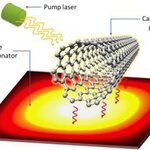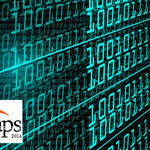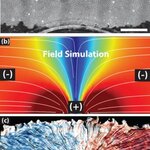Technology

A new Neurogrid circuit board can simulate orders of magnitude more neurons and synapses than other brain mimics - on the power it takes to run a tablet computer.
For all their sophistication, computers pale in comparison to the brain. The modest cortex of the mouse, for instance, operates 9,000 times faster than a personal computer simulation of its functions. Not only is the PC slower, it takes 40,000 times more power to run, says Kwabena Boahen, associate professor of bioengineering at Stanford.
Boahen and his team have developed Neurogrid, a circuit board consisting of 16 custom-designed…

A new version of SPASER (surface plasmon amplification by stimulated emission of radiation) technology being investigated could mean that mobile phones become so small, efficient, and flexible they could be printed on clothing. 'Hey, is that your t-shirt ringing or mine?'
Researchers have modeled the world's first SPASER to be made completely of carbon.
As you guessed by the definition, because the SP replaces the L in LASER, a
SPASER
is effectively a nanoscale laser or nanolaser. It emits a beam of light through the vibration of free electrons, rather than the space-consuming…

20 years ago, your parents knew there were two things you did not discuss with dinner guests. Your grandparents knew it, your great-grandparents knew it. 2,000 years ago people knew it.
In 2014, we are so much smarter we no longer know it.
Maybe some surveys will help. And so to help us out, two papers address the most pressing topic in popular culture - how people feel about being un-friended on Facebook. Ironically, they found this out by surveying people on Twitter.
Who is the person most likely to be un-friended on Facebook? Survey says: A high school acquaintance. Why? Probably…

Are you on the go a lot? Is your time so limited even moving your eyeballs is putting you behind?
If so, there is an app for that. If not, app developers are looking to create a market for that kind of personalized optimization, so they have devised speed-reading software that eliminates the time we supposedly waste by moving our eyes as we read.
Are eyes just passive conduits getting in the way of the modern world with their ancient biological mechanism?
A paper in Psychological Science argues that eye movements we make during reading actually play a critical role in our…

At the International Society for Heart and Lung Transplantation (ISHLT) 34th Annual Meeting in San Diego, TransMedics announced results of the PROCEED II heart transplant Food and Drug Administration (FDA) pivotal trial results using the Organ Care System (OCS™) platform.
PROCEED II Trial is a large international, multi-center, clinical trial designed to evaluate the ability of the OCS Heart Technology to preserve donor hearts compared with cold storage.
Since the early days of organ transplantation, the cornerstone of organ preservation has been cold ischemic storage - essentially, placing…

ReferralPlus is a tool to match patients who disqualify for one study with others they might qualify for, using a geo-therapeutic matching algorithm with other studies, similar to how OpenTable matches people with the restaurants they are interested in by using demographic and time availability algorithms. It was created because 95% of patients who respond to a trial recruitment advertisement do not qualify and/or enroll in that study.
Most of those patients never enroll in another study.
In 2012, ePharmaSolutions, developer of ReferralPlus, organized more than 30 major…

The National Space Biomedical Research Institute (NSBRI), based at Baylor College of Medicine, is a consortium of biomedical institutions that study the health risks related to long-duration spaceflight and developing the technologies and countermeasures needed for human space exploration missions.
The EyeBoxCNS, a diagnostic device developed to assess brain health through tracking eye movement, and eFormulations, software enabled therapeutics which combine prescription medicines with customized software apps for brain-related conditions, have both been funded for further development by NSBRI…

Most academics don't like competition but in the field of artificial intelligence, everyone wants to square off against the best in their discipline.
In June, the International Planning Competition held every two years will take place in New Hampshire. It is divided into four categories, the most significant of which is considered the “deterministic track”. This is for programs designed to eliminate any element of chance from automated planning in a wide range of fields, such as logistics, robot manipulation, satellite movement and transport.
Yes, the big money in AI is…

A recent Newsweek article claimed that the mystery of the brains behind Bitcoin had been solved - and Dorian S. Nakamoto was the guy.
The primary author of the celebrated
cryptocurrency
Bitcoin paper has remained unknown. Bitcoin is an Internet-based virtual currency which allows users to buy goods and services online. The payment system, introduced in 2009, is supposedly easier and safer than sending money via more traditional means. Using Bitcoin to pay for items also means avoiding credit card, foreign exchange or cash handling fees.
A new examination, nicknamed ‘Project Bitcoin’, was…

Researchers have used an electrical current to orchestrate the flow of a group of cells, an achievement that could establish the basis for more controlled forms of tissue engineering and for potential applications such as "smart bandages" that use electrical stimulation to help heal wounds.
In the experiments, the researchers used single layers of epithelial cells, the type of cells that bind together to form robust sheathes in skin, kidneys, cornea and other organs. They found that by applying an electric current of about five volts per centimeter, they could encourage cells to migrate along…